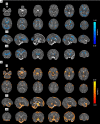MRI studies of brain size and growth in individuals with congenital heart disease
- PMID: 34584889
- PMCID: PMC8429874
- DOI: 10.21037/tp-20-282
MRI studies of brain size and growth in individuals with congenital heart disease
Abstract
Congenital heart disease (CHD) is the most frequent congenital abnormality. Most infants born with CHD now survive. However, survivors of CHD are at increased risk of neurodevelopmental impairment, which may be due to impaired brain development in the fetal and neonatal period. Magnetic resonance imaging (MRI) provides objective measures of brain volume and growth. Here, we review MRI studies assessing brain volume and growth in individuals with CHD from the fetus to adolescence. Smaller brain volumes compared to healthy controls are evident from around 30 weeks gestation in fetuses with CHD and are accompanied by increased extracerebral cerebrospinal fluid. This impaired brain growth persists after birth and throughout childhood to adolescence. Risk factors for impaired brain growth include reduced cerebral oxygen delivery in utero, longer time to surgery and increased hospital stay. There is increasing evidence that smaller total and regional brain volumes in this group are associated with adverse neurodevelopmental outcome. However, to date, few studies have assessed the association between early measures of cerebral volume and neurodevelopmental outcome in later childhood. Large prospective multicentre studies are required to better characterise the relationship between brain volume and growth, clinical risk factors and subsequent cognitive, motor, and behavioural impairments in this at-risk population.
Keywords: Congenital heart disease (CHD); brain; brain volume; magnetic resonance imaging (MRI).
2021 Translational Pediatrics. All rights reserved.
Conflict of interest statement
Conflicts of Interest: The authors have completed the ICMJE uniform disclosure form (available at http://dx.doi.org/10.21037/tp-20-282). The series “Pre-natal Diagnosis in Congenital Heart Defects” was commissioned by the editorial office without any funding or sponsorship. IHXN reports other from National Institute for Health Research, outside the submitted work. SJC reports grants from Medical Research Council (UK), grants from Action for Medical Research, grants from British Heart Foundation, during the conduct of the study. The authors have no other conflicts of interest to declare.
Figures

Similar articles
-
An exploratory fetal MRI study examining the impact of 22q11.2 microdeletion syndrome on early brain growth.J Neurodev Disord. 2025 Feb 12;17(1):7. doi: 10.1186/s11689-025-09594-9. J Neurodev Disord. 2025. PMID: 39939911 Free PMC article.
-
Total and Regional Brain Volumes in Fetuses With Congenital Heart Disease.J Magn Reson Imaging. 2024 Aug;60(2):497-509. doi: 10.1002/jmri.29078. Epub 2023 Oct 17. J Magn Reson Imaging. 2024. PMID: 37846811 Free PMC article.
-
3-D volumetric MRI evaluation of the placenta in fetuses with complex congenital heart disease.Placenta. 2015 Sep;36(9):1024-30. doi: 10.1016/j.placenta.2015.06.013. Epub 2015 Jul 6. Placenta. 2015. PMID: 26190037 Free PMC article.
-
Fetal Brain Development in Congenital Heart Disease.Can J Cardiol. 2023 Feb;39(2):115-122. doi: 10.1016/j.cjca.2022.09.020. Epub 2022 Sep 27. Can J Cardiol. 2023. PMID: 36174913 Free PMC article. Review.
-
Neuroplacentology in congenital heart disease: placental connections to neurodevelopmental outcomes.Pediatr Res. 2022 Mar;91(4):787-794. doi: 10.1038/s41390-021-01521-7. Epub 2021 Apr 16. Pediatr Res. 2022. PMID: 33864014 Free PMC article. Review.
Cited by
-
Radiomics with structural magnetic resonance imaging, surface morphometry features, neurology scales, and clinical metrics to evaluate the neurodevelopment of preschool children with corrected tetralogy of Fallot.Transl Pediatr. 2024 Sep 30;13(9):1571-1587. doi: 10.21037/tp-24-219. Epub 2024 Sep 26. Transl Pediatr. 2024. PMID: 39399711 Free PMC article.
-
An exploratory fetal MRI study examining the impact of 22q11.2 microdeletion syndrome on early brain growth.J Neurodev Disord. 2025 Feb 12;17(1):7. doi: 10.1186/s11689-025-09594-9. J Neurodev Disord. 2025. PMID: 39939911 Free PMC article.
-
Postnatal Brain Trajectories and Maternal Intelligence Predict Childhood Outcomes in Complex CHD.J Clin Med. 2024 May 15;13(10):2922. doi: 10.3390/jcm13102922. J Clin Med. 2024. PMID: 38792464 Free PMC article.
-
Validation of a Paralimbic-Related Subcortical Brain Dysmaturation MRI Score in Infants with Congenital Heart Disease.J Clin Med. 2024 Sep 27;13(19):5772. doi: 10.3390/jcm13195772. J Clin Med. 2024. PMID: 39407833 Free PMC article.
-
Individualized cortical gyrification in neonates with congenital heart disease.Brain Commun. 2024 Oct 7;6(5):fcae356. doi: 10.1093/braincomms/fcae356. eCollection 2024. Brain Commun. 2024. PMID: 39429246 Free PMC article.
References
Publication types
Grants and funding
LinkOut - more resources
Full Text Sources
